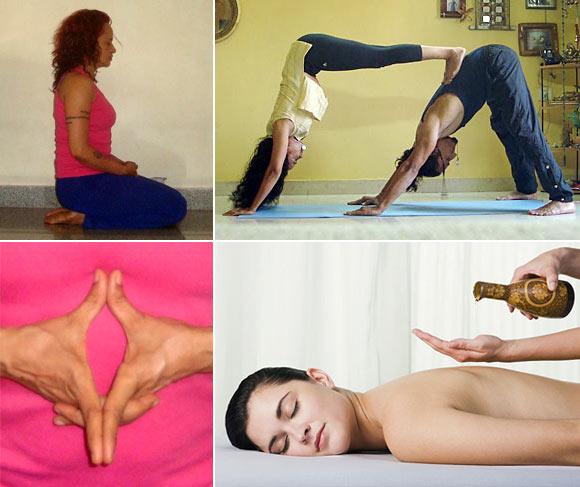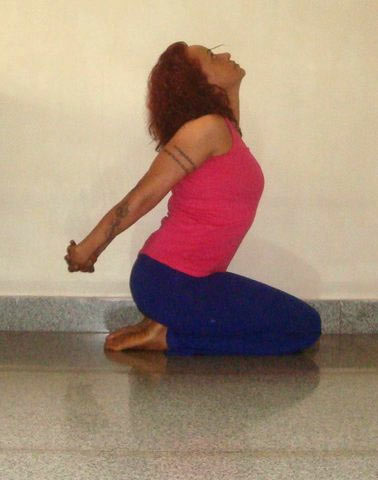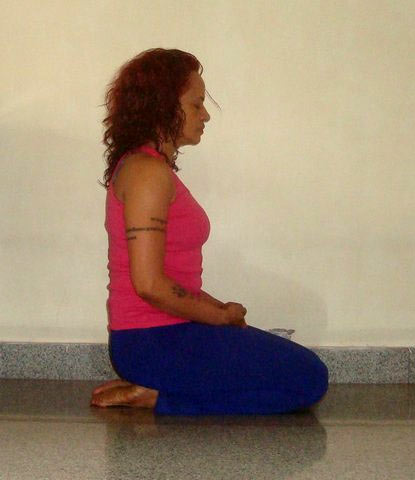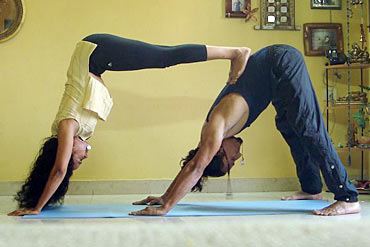 | « Back to article | Print this article |
Valentine's Day: Learn to love, the Yoga way
Shameem Akthar, yogacharya trained with the Sivananda Yoga Vedanta Center, takes you through five different methods that can help you connect with your loved one.
Yoga talks of love, at the heart center, or the anahata chakra. The yogic reference to love has several overtones, apart from the obvious between a couple. It involves self-engagement and self-acceptance, as one of these loves. Ability to love another, as oneself, is another. The ability to love the rest of the universe, including animate and inanimate objects so you see them infused with cosmic love is its larger perspective.
The love center is a higher chakra, transcending our animal instincts and transmuting it into the divine. Several poses and practices engage and activate this center which must, to really benefit us, flow in a harmonious fashion.
When it overflows, it could harm by extending love to others at our expense.
When it underflows, it can hurt by making one feel loveless and distanced from the world.
MUST READ: 5 great partner yoga poses
MUST SEE: Exercise and fun with Partner Yoga
Choose your gift on Rediff Shopping!
Post messages for your Valentine below!
Valentine's Day: Learn to love, the Yoga way
Meditation, with aroma oils
Sitting for meditation, or using aroma oils that activate the heart center, can improve the aura of love in your surroundings. Light an aroma diffuser (available in most life-style sections of shops), with any of these essential oils: rose, neroli, ylang ylang, and melissa.
These are extremely sweet smelling oils and also prized as aphrodisiacs and mood elevators. Sit in any cross-legged posture, or on the heels as shown (vajrasana/thunderbold pose).
Place hands in any mudra (hand gesture of your choice, and see the one below, for further suggestion). You may mediate for a minimum of 20 minutes, with eyes shut, focusing on the spot at the center of the rib cage. The fragrance from the oils will elevate your mood, and hang in the air for hours after the tea light candle burns out.
It would ideal if you could meditate with your partner or the person you love, to help deepen your connection. You may also use incense sticks made of these essential oils, though these (apart from rose) are not so easily available.
Benefits
Meditation clears the mind of confusions in a relationship, gives a clear perspective. The oils used also promote deep feelings of calmness. These are also mood elevating oils. They give you a high. They are regarded as aphrodisiacs and make others in the room also remain calm and loving.
It can defuse anger, negativities and emotional turmoil. It can heal hurt love.
Choose your gift on Rediff Shopping!
Post messages for your Valentine below!
Valentine's Day: Learn to love, the Yoga way
Skanda chakra (shoulder circle, simple version)
Sit either cross-legged, or on the heels as shown. Interlock fingers as shown, behind your back, resting them lightly. Inhale, lifting your head up, and simultaneously drawing the head and the chin up, as shown.
Continue normal breathing, pushing the chest out, as shown. Draw the hands up, as much as you can. Hold this pose for five to ten seconds. Do it thrice or five times. Rest with your hands alongside the body, forehead to the ground, before breaking the pose.
Benefits
This pose activates the love center. Elevates mood, removes lethargy and de-stresses.
Choose your gift on Rediff Shopping!
Post messages for your Valentine below!
Valentine's Day: Learn to love, the Yoga way
Yoni Mudra( Hand gesture of the female aspect)
Sit any meditative pose, referred to above. Place the hands together, with the index fingers of each hand touching, as well as the thumbs (of either hand) to create the shape indicated.
Other fingers are interlocked.
Place this hand at the chest, so the thumbs touch the heart center. It is very calming practice, harmonises the love center. You may meditate with this hand gesture for 20 minutes. However if you are new to this practice, the hands may tire after sometime, so do as much as you can only initially.
It is a good practice to be attempted with your partner, inviting him or her to meditate along with you.
Benefits
This mudra is deeply calming. Removes anger. Irrespective of your gender, it encourages the yin (female) aspect of your personality, which keeps you cool, calm, objective and centered.
Choose your gift on Rediff Shopping!
Post messages for your Valentine below!
Valentine's Day: Learn to love, the Yoga way
Meditation on the colour pink
Sit with your partner for meditation, assuming either a cross-legged posture or on the knees. Place your hands loosely on top of each other, with the left hand on top of the right (this is the Bhairavi mudra).
Keep your eyes shut. Shift your mental focus to your heart center, visualising the colour pink. You may also try to visualise on the colour green, which is the other shade attributed to the heart center.
Both colours have a powerful impact on the nervous system, cooling the mind down. Focus on creating this colour as a pulsing shade, or a spreading one. You may also visualise an object in this colour, such as a pink flower. Or greenery. Stay in this meditation for 20 minutes to feel the dramatic impact of this practice.
Benefits
Colour therapists will tell you that pink colour elevates the mood, fills you with joy. The undercurrent to this may be the ability to accept oneself, and therefore, another person, unconditionally.
The colour green, though equally elevating, is more soothing than stimulating. It is a healing colour. Those who seek to recover from love hurts may choose this colour, to heal and forgive and move on. Those who are in love and seek to improve it may choose the pink shade.
Choose your gift on Rediff Shopping!
Post messages for your Valentine below!
Valentine's Day: Learn to love, the Yoga way
Partner yoga
Partner yoga is only ideal between two people who have already done yoga before. It also calls for intense awareness and ability not to suddenly shift the body. It can only be done where there is a connection and communication between the partners. If there is no communication then there may be sudden movements that can be unsettling and may even cause injuries.
It is best learnt with an instructor who can show you how to enter and exit a pose. Most partner yoga poses look intimidating. However, they are rather easy. In fact make the difficult poses become easier because the muscular burden of balance and power is equally shared by two people.
Downward-facing dog pose(Adhomukha svanasana)
One partner (let's refer to this person as A) gets into this pose which is also called the inverted V-pose. The other person (let's refer to this person as B) stand a few feet in front of this person, whose head is now down.
Then B bends down to place both hands on the ground, palms firmly down. Then B lifts the right foot to place it on the upper back of A. Then, gently places the other foot also on A's upper back. 'A' continues to look down.
Now B lifts one of the legs aloft, as shown. Then drops it back. Repeats it with the other leg. Then gently exits the pose by first removing one foot from A's back, then the other, to stand up. Now A could repeat the steps of B.
Benefits
Partner yoga poses create trust, connection and communication skills. It may be attempted by anybody regardless of the size of either partner. It can be a rather exciting revelation of how a pose may be shared and actually be made light, when partnered.
Choose your gift on Rediff Shopping!
Post messages for your Valentine below!






